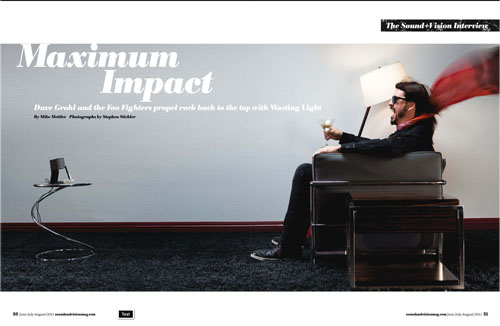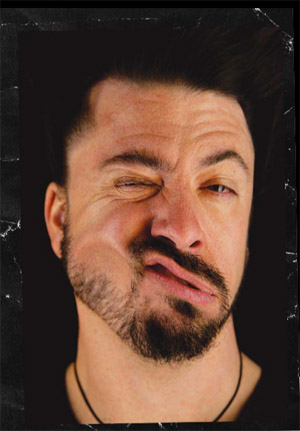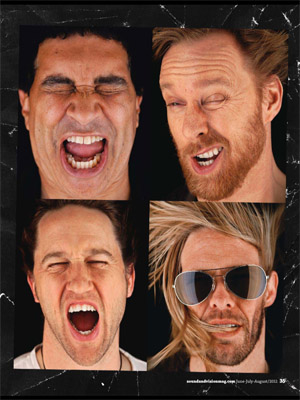Maximum Impact
Sound + Vision
Dave Grohl and the Foo Fighters propel rock back to the top with Wasting Light
 Dave Grohl and I are crouched together on a hot blacktop driveway that encircles the SoCal locale where the photo session for this exclusive S+V cover story is taking place. To the onlookers who shuffle past us and sometimes hover at a not always respectful distance, it appears as if these two hunched, animated, close-talking bearded longhairs are plotting to take over the world — and perhaps that's not an entirely wrong assumption. Actually, we're bended-knee deep in the midst of dissecting the reasons why Wasting Light (Roswell/RCA), the Foo Fighters' first No. 1 album in their 16-year career and a welcome, hearty rock & roll punch to the gut of music-sales erosion, exudes such lasting sonic vigor. (Well, there's that, and there's the “hells yeah!” realization of our mutual admiration for Led Zeppelin's In Through the Out Door and love of AC/DC's Black Ice tour. But I digress.)
Dave Grohl and I are crouched together on a hot blacktop driveway that encircles the SoCal locale where the photo session for this exclusive S+V cover story is taking place. To the onlookers who shuffle past us and sometimes hover at a not always respectful distance, it appears as if these two hunched, animated, close-talking bearded longhairs are plotting to take over the world — and perhaps that's not an entirely wrong assumption. Actually, we're bended-knee deep in the midst of dissecting the reasons why Wasting Light (Roswell/RCA), the Foo Fighters' first No. 1 album in their 16-year career and a welcome, hearty rock & roll punch to the gut of music-sales erosion, exudes such lasting sonic vigor. (Well, there's that, and there's the “hells yeah!” realization of our mutual admiration for Led Zeppelin's In Through the Out Door and love of AC/DC's Black Ice tour. But I digress.)
The most important reasons for Light's primal, visceral appeal are directly tied to how it was recorded: in dutiful all-analog fashion onto tape with no Pro Tools “smoothing” allowed, per Grohl's explicit orders out of the box to producer Butch Vig. Plus, as Dave mentions in bold above, it was also made in quite the coziest of settings — his garage, which was retooled and recast as an intimate recording suite. Usually, the Foos cut their tracks at Studio 606, their own collective two-story recording haunt/compound located in Northridge, California. But this time around, Grohl had a different idea.
“The analog recording concept was simple to me,” he says. “I just imagined that's the way it should be done. The simple signal path of a microphone into an EQ and then into the tape machine — plus not having to scroll through Pro Tools menus — means you're restricted to actual performance, which is good. It makes you sound like a human being. And that's just f---ing awesome.”
Being human — good, bad, indifferent — is what Wasting Light is all about. “Rope” drags you in with Grohl's intro, a chiming delayed guitar riff in the left channel followed by his doubled lead vocal down the middle and the band's full onslaught. The song throws a curve with a dead stop halfway through before the pummeling returns, fueled by drummer Taylor Hawkins's insistent cymbal crashing and Nate Mendel's table-setting bass underneath further hammering from the Grohl/Chris Shiflett/Pat Smear guitar axis. The anthemic “These Days” unfolds with an understated Grohl vocal and is buttressed by Rush-meets-the-Cure guitar textures. “I Should Have Known,” Grohl's most direct statement to date about the loss of Nirvana bandmate Kurt Cobain (and possibly some other fallen comrades), benefits from the imprint of surviving Nirvana compatriot Krist Novoselic, who supplies both the bottom end and accordion. Strings from Jessy Greene and mellotron from Rami Jaffe contribute to its overall stark vibe. And after you've been sufficiently drained by that particularly cutting track, you get treated to “Walk,” the album's uplifting and hopeful coda, which cleanses the palate and closes the album at a just-right 48 minutes.
That Light has garnered such immediate gut-level responses from a wide swath of listeners — many of them quite happy to pay the freight to consume it via CD, download, and/or vinyl — has a lot to do with the tape-only recording approach. “To me, tape doesn't lie,” Grohl states. “You can do as much as you can to make a performance sound great, but at the end of the day, it's you. And that's it. Digital recording equipment can be useful and handy, but it's almost like Frodo's ring: You don't want to put it on the wrong person.” He chuckles, then adds, “The idea of using tape was to preserve the band's personality.”
Producer Vig, who first worked with Grohl on Nirvana's groundbreaking Nevermind some 20 years ago (gulp!) and then returned to steward two new songs on the Foos' 2009 Greatest Hits collection (“Wheels” and “Word Forward”), warmed up to the all-analog dictum fairly quickly. “After thinking about it, I said, ‘Well, you guys have to play pretty good. You can't fix anything. No multiple playlists, no autotune, none of that,’” he recalls. “And the band was psyched about it. I think they really felt like they wanted a challenge. It's easy to fall into patterns, and Pro Tools — I love it, but it makes things too easy. When you go back to tape, it's all about performance.”
The band agrees that recording to tape was liberating. “It got everyone out of their comfort zone,” notes Shiflett. “That's one of the best things about recording with tape instead of Pro Tools. If you record digitally, you'll say, ‘Oh, don't print it with that effect on it; we'll fix it later.’ With tape, if you had your pedal and chorus going all out, there was no manipulating them after the fact. And it made mixing easier, too. Albums used to be recorded this way — you were essentially recording and mixing at the same time.”
 Adds Smear, “One thing we all committed to: Whatever we did, we didn't change. If a distorted vocal went through a pedal, that's how it was going to end up on the record.”
Adds Smear, “One thing we all committed to: Whatever we did, we didn't change. If a distorted vocal went through a pedal, that's how it was going to end up on the record.”
That speaks volumes about a band wanting its music to come across as honest, warts and all. “It's like when we were kids on the punk-rock scene,” recalls Grohl. “It was all about integrity. It was important that your intentions were right on. It didn't matter if you sounded like New Order, the Dead Kennedys, or whatever; as long as your intentions were real and you were doing the right thing, people would appreciate you for that. I still feel the same way, you know?”
So, to borrow a line, is it really just a question of your honesty — yeah, your honesty? “You gotta give people something to believe in,” nods Grohl. “That's a real issue people have with music sometimes. They don't know whether to believe in it or not. Are these guys being ironic, or are they not? Is that a machine, or is it music? Can he really sing that note? There's something to be said for what someone like Jack White does: It's so great because it is what it is.”
Hawkins very much agrees with Grohl about the multitalented Jack-of-All-Trades White. “He does it in a way that just feels right. I want to hear tone, I want to hear bass, I want to hear feel. We cut a B-side the other day, and when I was listening to the playback, I noticed how real it was, and how organic it was — that bit of pushing and pulling. A real feel is what's most important to me.”
One area in which Hawkins and Grohl believe that digital recording is lacking is capturing the sound of the drums. “There's a plasticness to digital recording, and a lot of that comes from the drums,” observes Hawkins. “That's the thing that changes the most — the sound of the kit. When you listen to a Zeppelin record, you can hear the toms and every mike, even if there were only three mikes on those drums.”
Notes Grohl, “As a drummer growing up listening to punk-rock records, Zeppelin records, and Who records, I had my favorite drummers, because every one of them had their own personality and character. It was like a fingerprint. You knew their feel, and their personality was rooted in their imperfections. So why not celebrate that? There's just something about the tone and sound of the tracks on Wasting Light that has the character of my garage. And the drum sound on it is exactly the way it sounded in the garage.”
Hawkins knows why it goes even further than that. “It's taken a while for the sound of this band with me playing drums, and not Dave, to totally develop. You heard it a little bit on past records, but because this one's on tape and there was no Pro Tools, it really sounds like what our band sounds like, good or bad.”
The drummer laments the current state of big-budget clean-it-up recording. “If you go into a studio now, this is the setup: There's a producer and an engineer, and maybe a second engineer to move the mikes. And then there's another room where a dude is sitting on his computer. He doesn't even know the music that's going down. The files go to him, he looks at them, makes them ‘perfect,’ and gives them back to you: ‘Here you go.’ Well, sorry, but no thanks.”
You want live? You got it! As the summer rolls on, playing Light live is where it's at, and the Foos are currently storming across Europe and packing stadiums before they return to fill our hungry Stateside ears. Back in the spring, the band popped into clubs with little notice and played the new album start to finish. “Playing through the whole album felt pretty good,” enthuses Mendel. “It's the best thing we've done in a long time. There's not a lot of flab to deal with.” Admits Hawkins, “It's going to get harder to wean ourselves off of playing it that way for those big, proper arena shows.”
Observes Grohl about the club-show atmosphere: “That's the greatest gauge. You come out and say, ‘Hey, you guys wanna hear the new record?’ ‘Yeah!’ So you do it and watch the immediate reaction happening right in front of you. You can't get any more real than that. Because when I pull this thing out of the garage, I want it to fucking shine.
 “There's something about being able to see the people onstage doing what you're hearing — seeing five guys tear it up for 4 minutes at a clip,” he continues. “No computers are behind them, and no one under the stage is doing keyboards. That is a rock & roll band, my friend.” Head over to foofighters.com to see when and where you'll be able to catch 'em live.
“There's something about being able to see the people onstage doing what you're hearing — seeing five guys tear it up for 4 minutes at a clip,” he continues. “No computers are behind them, and no one under the stage is doing keyboards. That is a rock & roll band, my friend.” Head over to foofighters.com to see when and where you'll be able to catch 'em live.
Ever the vigilant A/V-collectophile, I duly noticed that early runs of the Wasting Light CD claimed to include, according to a sticker on the front, “a piece of the master tape.” (BTW, the other instruction on that sticker: “Please play at maximum volume.” Done!) I bought two copies at two different locations to, er, fact-check said claim, and I do indeed have in my possession two 1-inch strips of tape. So are they real, or are they Foo-orex?
“Yes, they're real,” Vig confirms with a laugh. “We cut all of the tape up, so anyone who buys the first run of the CD gets a 1-inch piece of that tape. I think that's pretty cool.” Here's how Vig says his initial exchange with Grohl went down about the cut-tape idea.
DAVE: I don't want us to have any digital backups while we're making this record.
BUTCH: But if the tape breaks or something goes bad, we're screwed!
DAVE: Well, I guess we'll end up having to do those songs again.
BUTCH: Okay, man, you've got some big balls for saying that.
DAVE: We'll make safeties of everything when we're done. And then I want to destroy all the tapes. I want to slice them up into 1-inch pieces and put them into the CD package.
BUTCH: Are you out of your mind? We've been slaving over this for 3-and-a-half months. How can you just destroy the tape?
DAVE: Because it's done. We've moved away from it. It's out in the world. It's a living, breathing thing now.
So, my last (and, I think, quite logical) question to Vig about this whole master-tape situation was: How many of these mini tape segments would I have to splice together to actually hear something tangible? “Let's see. That 1 inch of tape is about 1/30th of a second, so good luck figuring that out! Plus, I don't know what's on the tape you've got; it could be an outtake, or something from one of the master songs, but it is all 24-track.” Pause. “We could probably run it at a slower speed to figure out what it is.” Fair enough, but I suppose there's no telling how any of these splices will sound together before playback; talk about random sampling…. But, hey, either way, I'm game. Anybody want to chip in and buy a couple hundred or so Wasting Light CDs to see what we can seam together? Name That Tune has just taken on a whole other meaning….
Words: Mike Mettler
back to the features index
 Dave Grohl and I are crouched together on a hot blacktop driveway that encircles the SoCal locale where the photo session for this exclusive S+V cover story is taking place. To the onlookers who shuffle past us and sometimes hover at a not always respectful distance, it appears as if these two hunched, animated, close-talking bearded longhairs are plotting to take over the world — and perhaps that's not an entirely wrong assumption. Actually, we're bended-knee deep in the midst of dissecting the reasons why Wasting Light (Roswell/RCA), the Foo Fighters' first No. 1 album in their 16-year career and a welcome, hearty rock & roll punch to the gut of music-sales erosion, exudes such lasting sonic vigor. (Well, there's that, and there's the “hells yeah!” realization of our mutual admiration for Led Zeppelin's In Through the Out Door and love of AC/DC's Black Ice tour. But I digress.)
Dave Grohl and I are crouched together on a hot blacktop driveway that encircles the SoCal locale where the photo session for this exclusive S+V cover story is taking place. To the onlookers who shuffle past us and sometimes hover at a not always respectful distance, it appears as if these two hunched, animated, close-talking bearded longhairs are plotting to take over the world — and perhaps that's not an entirely wrong assumption. Actually, we're bended-knee deep in the midst of dissecting the reasons why Wasting Light (Roswell/RCA), the Foo Fighters' first No. 1 album in their 16-year career and a welcome, hearty rock & roll punch to the gut of music-sales erosion, exudes such lasting sonic vigor. (Well, there's that, and there's the “hells yeah!” realization of our mutual admiration for Led Zeppelin's In Through the Out Door and love of AC/DC's Black Ice tour. But I digress.)

